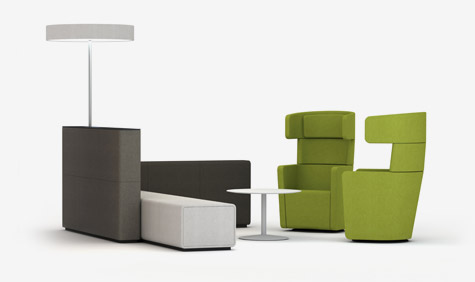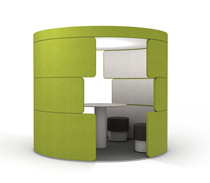New office furniture by Pearson Lloyd

Pearson Lloyd launch their new office furniture collection for Bene today. In an exclusive first showing of the Parcs range, we catch up with the duo and discover that inspiration for designing for the workplace was certainly not confined to the study.

See the full collection, plus images of it in situ
What is Parcs?
Parcs is a new collection of furniture that we have designed for Bene. In any office people can often be productive and creative away from their desks so the idea was to create furniture – and by extension new meeting environments – that acknowledges this. The range includes Causeway (a collection of simple modular benches, fences and walls), Toguna (a semi private meeting space that occupies the common areas in the workplace) and Wing (a semi-private space for thinking, taking a call, reading, snoozing).
How did you come to work with Bene?
Bene is a family-run Austrian company that is almost 200 years old and it’s one of the biggest furniture companies in Europe. We started talking to them about five or six years ago, although we knew then that they very rarely commissioned external designers because all their products are created in-house. We were very impressed with them – they have an extraordinary sales structure meaning their products are always very quick to market, and the design is very high quality – quite dry, in a sort of modernist way.
What is new in workplace design?
Wallpaper* Newsletter
Receive our daily digest of inspiration, escapism and design stories from around the world direct to your inbox.
The context for this range is the maturing market around office “breakout” areas – it’s all about how to be productive away from your desk. Office furniture has traditionally been about the desk, and the meeting room, with perhaps a lounge area somewhere in between that serves little more function than branding – it says to visitors “we’re relaxed” but people are rarely encouraged to use it.
What’s the new workplace essential when it comes to furniture?
Fifteen years ago a business would spend its budget on desks and chairs. Now – as the office has opened up - we have seen the desk become a commodity and the spend all goes on the task chair. We’re starting to see the “other” section mature, as companies recognise how much work goes on – chatting, workshops, reading – that isn’t necessarily supported by a desk or a traditional meeting room.
What key issues did you set out to address with Parcs?
Privacy is a key issue that often isn’t properly considered in offices and something we wanted to look at.
Where did you find the inspiration?
Bene allowed us a great deal of time and support to do a load of work without anyone knowing exactly where it was going to go. They’ve never worked in this sector before. We embarked on a long and fascinating research process before designing anything – starting with looking at the functions without the furniture – what are people doing in an office? What are the ergonomic needs? In the end we found inspiration everywhere – from confessional booths to the Giants Causeway and the Togunas in Mali.
The Togunas in Mali?
My (Tom Lloyd) wife is a social anthropologist and has been doing some research for her own work in Mali, West Africa. She came across a structure called a Toguna, where the elders of the tribes will go to meet. The Toguna is only 1m high, so when you are sitting inside it you can’t stand up – it keeps people calm if there is a heated discussion because if you stand suddenly in protest you hit your head.
And the Giants Causeway?
Also the Spanish Steps – we looked at these spaces and found them fascinating how any group of people, say a family or a group of friends – will always find their own way to use the space. And we also looked at restaurants and beaches, where proximity to other people doesn’t have to compromise security – all you need is a beach umbrella or a targeted pool of light on your table.
How did these ideas manifest in Parcs?
The process from inspiration to design was relatively straightforward – we didn’t want to layer the objects with too many meanings, and we found that the products almost just emerged from the brief building. Funnily enough, it’s been a good fit with the other projects we are working on too – including a project to develop the public realm and movement strategy for the City of Bath – looking at social interaction and the way people behave, it’s almost identical in some ways.
Rosa Bertoli was born in Udine, Italy, and now lives in London. Since 2014, she has been the Design Editor of Wallpaper*, where she oversees design content for the print and online editions, as well as special editorial projects. Through her role at Wallpaper*, she has written extensively about all areas of design. Rosa has been speaker and moderator for various design talks and conferences including London Craft Week, Maison & Objet, The Italian Cultural Institute (London), Clippings, Zaha Hadid Design, Kartell and Frieze Art Fair. Rosa has been on judging panels for the Chart Architecture Award, the Dutch Design Awards and the DesignGuild Marks. She has written for numerous English and Italian language publications, and worked as a content and communication consultant for fashion and design brands.
-
 Japan in Milan! See the highlights of Japanese design at Milan Design Week 2025
Japan in Milan! See the highlights of Japanese design at Milan Design Week 2025At Milan Design Week 2025 Japanese craftsmanship was a front runner with an array of projects in the spotlight. Here are some of our highlights
By Danielle Demetriou
-
 Tour the best contemporary tea houses around the world
Tour the best contemporary tea houses around the worldCelebrate the world’s most unique tea houses, from Melbourne to Stockholm, with a new book by Wallpaper’s Léa Teuscher
By Léa Teuscher
-
 ‘Humour is foundational’: artist Ella Kruglyanskaya on painting as a ‘highly questionable’ pursuit
‘Humour is foundational’: artist Ella Kruglyanskaya on painting as a ‘highly questionable’ pursuitElla Kruglyanskaya’s exhibition, ‘Shadows’ at Thomas Dane Gallery, is the first in a series of three this year, with openings in Basel and New York to follow
By Hannah Silver